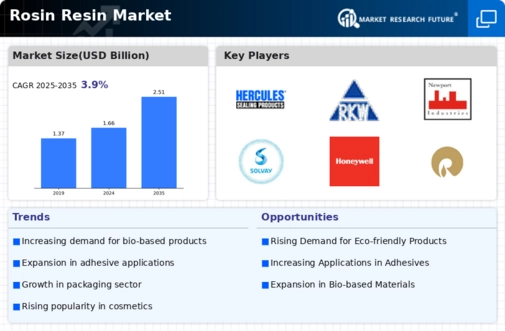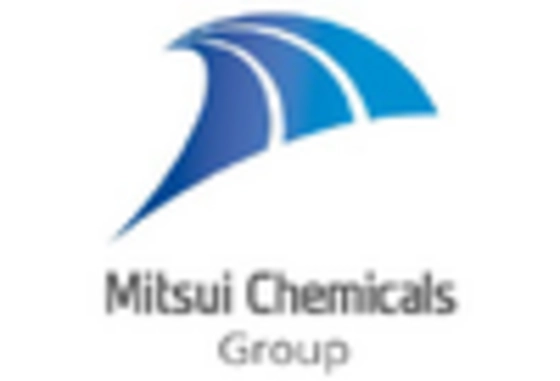Regulatory Support
Regulatory support is emerging as a vital driver for the Rosin Resin Market. Governments worldwide are implementing policies that favor the use of bio-based materials, including rosin resin, in various applications. In 2025, initiatives aimed at reducing reliance on petroleum-based products are expected to create a favorable environment for the growth of the rosin resin market. Compliance with environmental regulations may compel manufacturers to shift towards more sustainable materials, thereby increasing the demand for rosin resin. Additionally, incentives for research and development in bio-based materials could further stimulate innovation within the industry. As regulatory frameworks evolve, they are likely to provide a significant boost to the Rosin Resin Market, encouraging companies to invest in sustainable practices and products.
Growing Consumer Awareness
Growing consumer awareness regarding the benefits of natural and sustainable products is a key driver for the Rosin Resin Market. As consumers become more informed about the environmental impact of their choices, there is a noticeable shift towards products that are perceived as eco-friendly. In 2025, this trend is expected to influence purchasing decisions across various sectors, including cosmetics, food, and packaging. The demand for rosin resin, known for its natural origin and biodegradability, is likely to increase as consumers seek alternatives to synthetic materials. This heightened awareness may prompt manufacturers to highlight the sustainable attributes of their products, further driving the growth of the rosin resin market. Consequently, the growing consumer awareness appears to be a significant factor in shaping the future of the Rosin Resin Market.
Sustainability Initiatives
The increasing emphasis on sustainability is a pivotal driver for the Rosin Resin Market. As industries strive to reduce their carbon footprint, the demand for eco-friendly materials has surged. Rosin resin, derived from natural sources, aligns with these sustainability goals, making it an attractive alternative to synthetic resins. In 2025, the market for bio-based materials, including rosin resin, is projected to reach substantial figures, reflecting a growing consumer preference for sustainable products. This trend is likely to encourage manufacturers to invest in rosin resin production, thereby expanding its market share. Furthermore, regulatory frameworks promoting sustainable practices may further bolster the rosin resin market, as companies seek to comply with environmental standards. Thus, the sustainability initiatives appear to be a significant catalyst for growth in the Rosin Resin Market.
Technological Advancements
Technological advancements play a crucial role in shaping the Rosin Resin Market. Innovations in extraction and processing techniques have enhanced the efficiency and quality of rosin resin production. For instance, advancements in solvent-free extraction methods have improved yield rates, making rosin resin more economically viable. In 2025, the market is expected to benefit from these technological improvements, as they allow for the production of higher purity resins that meet stringent industry standards. Additionally, the development of new applications for rosin resin in sectors such as adhesives, coatings, and inks is likely to expand its market reach. As manufacturers adopt these technologies, the overall competitiveness of the rosin resin market may increase, leading to a more dynamic industry landscape. Therefore, technological advancements are poised to drive growth in the Rosin Resin Market.
Diverse End-Use Applications
The versatility of rosin resin is a significant driver for the Rosin Resin Market. Its applications span various sectors, including adhesives, paints, coatings, and food packaging. In 2025, the demand for rosin resin in the adhesive segment is projected to account for a substantial share of the market, driven by the construction and automotive industries. Furthermore, the increasing use of rosin resin in eco-friendly packaging solutions is likely to enhance its appeal among manufacturers seeking sustainable options. This diverse range of applications not only broadens the market base but also encourages innovation in product formulations. As industries continue to explore new uses for rosin resin, the market is expected to witness robust growth. Thus, the diverse end-use applications of rosin resin are likely to be a key factor in the expansion of the Rosin Resin Market.


















Leave a Comment